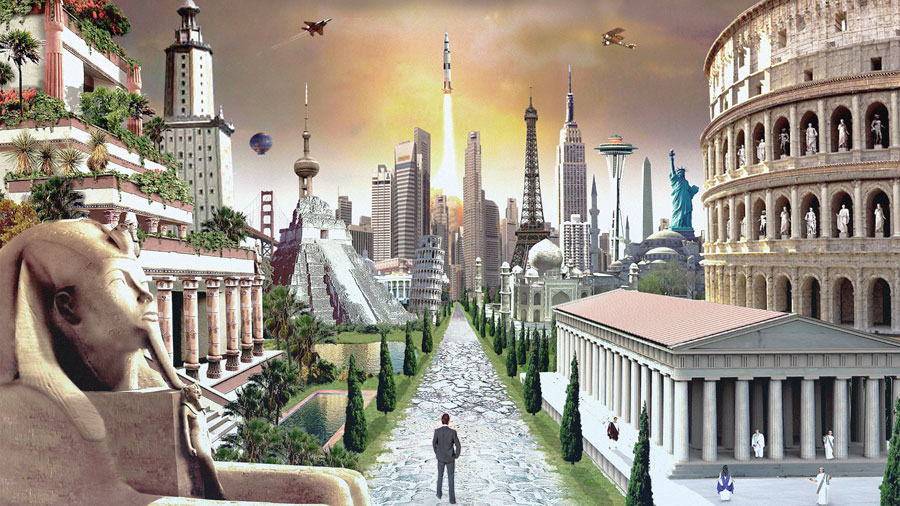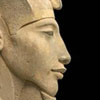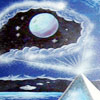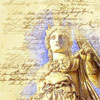Pathways In History
 by George Hunt Williamson
by George Hunt Williamson
The destruction of Lemuria did not take place in a single day or even a year. It covered a period of several thousand years; for the beginning of Mu goes back some two hundred thousand years. But the final catastrophe which caused the submergence of nearly all of Lemuria occurred about twelve thousand years ago. The only land left above ground was part of California, Arizona, and other parts of the American South West; Australia, and Easter Island.
Easter Island is the strange island in the south Pacific that contains monoliths and mysterious stone figures which science is at a loss to explain. The native population, which is very small, claim they know nothing of these figures. They are so huge and their construction so unique they could not have been made by savage, uncultured people. Easter Island is all that is left above water of a great Lemurian Holy Mountain—and the colossal figures belong to the culture of lost Mu.
Before the great civilization of Mu, there existed in the north Pacific a large continent known as Adoma. As it sank some five hundred thousand years ago, Lemuria rose in the south Pacific. A-Dom is a Lemurian word meaning “race of men from the red earth.” It has come down to us today as “Adam.”
The “T” or “TAU” cross, surmounted by a circle, is the Crux Ansata (Ankh) or the cross of life. It was the key to the mysteries of antiquity and gave rise to the more modern story of St. Peter’s golden key to heaven. The Crux Ansata migrated to many parts of the earth from Lemuria and Atlantis. It was originally the great fertility symbol of the people of Adoma, because it employs the masculine “TAU” and a feminine oval.
The migration of the Ankh or Crux Ansata is proven by the fact that it is found all over the world amongst ancient civilizations. It was plainly sculptured upon the back of at least one of the great stone figures found on Easter Island. This figure was brought to London by a sailing ship and is now in the British Museum.
The Crux Ansata also has been found adorning the breasts of statues and bas-reliefs at Palenque, Copan, and throughout Central America. This cross was always associated with water. Among the Babylonians it was the emblem of the water gods; among the Scandinavians of heaven and immortality; and among the Mayas of rejuvenation and freedom from physical suffering. In Egypt this cross signified immortality of the soul.
Many proofs can be given to show that Lemuria and Atlantis developed colonies all over the earth. But the migration of the Crux Ansata is given here as one point of proof because of its peculiar interest.
Lemuria transplanted its culture when it realized that eventual complete submergence would take place. They transplanted their culture both east and west. Vast hordes of people migrated westward—discovered the continent of Asia, populated Cambodia and Burma, pushed up into India and Tibet, and laid the basis for that racial development which was to come down into historic times as Chinese. They likewise crossed to the east coast of Africa and penetrated to the district now recognized as the source of the Nile.
The great colonization projects sent outward by Mu went to South America, Central America—even to Atlantis—then Europe, the Mediterranean area, Egypt, etc.
One of the greatest of Lemurian colonies existed in what is now the dense jungle of the Brazilian Matto Grosso. In 1925, Col. P.H. Fawcett disappeared in this wilderness looking for the ruins of great cities incomparably older than those of Egypt. He had read in an ancient, decaying document (Manuscript No. 512, Archives of the Biblioteca Nacional, Rio de Janeiro, Brazil), that these fabled cities actually existed. They were reported in the 1700s by a Portuguese explorer, who claimed they were built of gigantic stones. There were beautiful temples of Grecian style, and in the center of one city there was a plaza with a great, high stone statue of a naked youth holding a shield. On the base of this figure were curious hieroglyphics in an unknown language of a lost people. Both cities had been damaged by an earthquake, according to the Portuguese adventurer.
Another colony of the Motherland Mu was the highly advanced Inca civilization. This was one of the outstanding colonies of South America. Inca legends say that their great cities were constructed by bearded white men who came to South America long before the time of the Incas and established a settlement. The great roadways were ancient in the time of the Incas and were used by the Lemurians in early colonizing attempts.
The gigantic solid gold Inca Sun Disk was not of native Inca workmanship, but had been brought from Lemuria and was adored in temples for centuries in South America. It is said that when struck in peculiar vibrations could even cause earthquakes!
The Maya civilization of Central America was another great colony of Mu. It is claimed that a more correct pronunciation of “Mu” is “Mar,” and the word Maya, pronounced as May-yar, meant Colony of Mar.
It is also known that colonists from Atlantis also influenced Maya culture; so here we find both Lemurians and Atlanteans mingling and helping to develop the high civilization of ancient Central America.
Itzamna was the personification of the East amongst the Mayas. He was said to have come in his magic skiff from the east across the waters. He performed miracles such as the curing of the sick by the laying on of hands; he possessed the power of reviving the dead. He invented writing and books. He is always connected with symbols of life and light; it is he who is connected with the Maya tree of life! After instructing the Maya people, it is said that Itzamna returned to a land beyond the waters to the east from whence he came.
Kukulcan was the personification of the West amongst of Mayas. It was claimed that he arrived by way of the west and reigned for a while in the present vicinity of Chichen-Itza. Later he returned to Mexico and was known in that country as Quetzalcoatl.
According to early Spanish chroniclers of Maya history, Itzamna arrived in the fourth Ahau of the Maya calendar (A.D. 219). The earliest-dated Maya stone yet discovered bears the date of 96 B.C, so the coming of Itzamna in the fourth Ahau could not possibly be accurate! It would be impossible for Itzamna, no matter how great, to have “founded” the Maya culture—the architecture, letters, language, writing, and religion in the early part of the third century A.D.—when we have positive evidence of the culture’s existence in the same territory at least as early as 96 B.C.! It takes thousands of years to establish even a reasonably accurate calendar. How then could Itzamna invent the Maya calendar, which is almost perfect and put into use at the beginning of the third century A.D. when numerous tablets are in existence bearing undisputed dates of the Maya calendar at least three hundred years earlier?
The godlike attributes ascribed to Itzamna are identical with those assigned to other outstanding leaders of widely different periods. The Spanish chroniclers were very wrong! Itzamna, in order to be the “founder of the Maya culture and the first priest of their religion,” must have arrived thousands of years before 96 B.C.! He came in a “magic boat or skiff”—he came from a great land to the east! Actually, Itzamna was a great Atlantean who attempted colonization of the the natives of Central America! They deified him after he returned to Atlantis in his “magic boat” or slender airship.
Kukulcan was actually a teacher from Lemuria, who came from the west. So in the legends of the “gods of the east and west,” we find the proof that both Mu and Atlantis colonized Central America and taught the native Maya people.
Plato tells us that the civilization of Atlantis disintegrated with the last major sinking of Atlantis in approximately 9600 B.C. If Lemuria completed its submergence about twelve thousand years ago (ca. 10000 B.C.), this would mean that the final destruction of the Atlanteans took place only a few hundred years later.
Some of the great souls of Mu and her colonies incarnated in Atlantis during her “final hour.” These members of the “Goodly Company” wandered from one civilization to another—from one lifetime to another. They found themselves in many different civilizations, cultures, catastrophes, and developments, but it was all for the purpose of preparing mankind for the influx of great Universal Truths.
History records numerous instances of records being secreted away under threat of impending doom. And Atlantis was no exception to the rule. In the narrative given by Plato we read that the records of the Atlanteans were written on gold tablets “and deposited as memorials with their robes.”
Thus Atlantis passed away with only memory and a few islands (Azores, St. Paul’s, Ascension, Tristan da Cunha) that had been the peaks of mountains remaining. Survivors journeyed to Egypt, where a great civilization had already been founded in ca. 24000 B.C.
The Great Pyramid is situated exactly on the geographical center between Upper and Lower Egypt. Thus it is “in the midst” of Egypt as a whole and “on the borders thereof,” of both sections. The Great Pyramid is a fantastic encyclopedia of physical science and astral lore. The science of numbers, weights, measures, astronomy, astrology, and the secret mysteries of physiology are symbolized in that incomparable monument.
The Pyramid—the “altar” in the midst of Egypt—was reared by great masters from Atlantis and its construction was supervised by men from other worlds. They possessed wisdom that enabled them to solved the mystery of mysteries.
At the present time there is no evidence to prove that the Great Pyramid (Pyramid of Khufu, or Cheops) was erected in the Fourth Dynasty. Its extraordinary characteristics, unlike any other pyramid, assign to it far more importance than a mere burial mound. If it was built at the beginning of so-called Egyptian history, then the stupendous work is a contradiction. The execution of so vast a project reflects very high engineering skill, as all scholars admit. The workmanship is of the most advanced order. All evidence points to the fact that an advanced culture existed in Egypt thousands of years prior to the historic period of that country!
It will be revealed—and no doubt within a comparatively short time now—that there are many secret chambers within the Great Pyramid and that its true entrance lies under the silent object that is like a lion and yet like a man—the Sphinx!
The incomparable Great Pyramid shows us what was done in past ages, what is being done now, and what will be accomplished by future generations. In the King’s Chamber, which occupies the highest position yet discovered in the Pyramid, there is a very unique object. It has been given many names from sarcophagus to corn-bin. It is really a “womb within a womb”—a sacred chalice—and represents the pineal gland within the head of every human being.
The “sarcophagus” was not intended by its perfected builders to contain a dead body! The Pyramid was constructed over natural magnetic anomaly, and its pyramidal, cone-like shape amplified this natural force, and the Pyramid became, literally, an instrument of great cosmic energy and force. That is why there is a strange atmosphere and temperature in the King’s Chamber; a death-like cold that cuts to the marrow of the bone! And if the sarcophagus is struck, the sound emitted has no counterpart in any known musical scale! If anyone passed into the “valley of the shadow,” which was death, he could be restored by merely being placed in the uncovered sarcophagus! Later, the force diminished in the Pyramid, and initiates were placed in the stone “coffin” in a symbolic gesture of its former, ancient meaning.
Scientists have discovered a weak magnetic force still emanating from this gigantic structure, but it is no longer strong enough to perform its miracle of “from death into life.”
The King’s Chamber and the Queen’s Chamber stand in the same relation to each other as do the pineal gland and the pituitary body, the King’s Chamber being placed the highest, and likewise the pineal body. No trace of any lighting system has ever been found, for no system of lighting was needed. The perfected builders enjoyed full use of the All-Seeing Eye and were a light unto themselves—the radiance from the inner eye giving light to all that was within the temple. Near the top of the Great Pyramid there is the most secret of chambers. It contains written records of all world civilizations—a legacy for mankind that cannot even be imagined by modern man!
Sea shells at the base of the Pyramid prove that it was constructed before the great flood. This theory is substantiated by the much abused Arabian traditions. Therefore the Pyramid was constructed before the great floods caused by the final submergence of Atlantis which caused walls of water to engulf coastal areas and some interiors. It dates 24000 B.C. At this time the great Atlantean scientist, Thoth, came to Egypt to assist in the planning being conducted by space visitors. At the beginning of every new Cosmic Cycle (each lasting approximately twenty-six thousand years) a similar structure is built.
The Sphinx was built thousands of years later by the native workmen, for it is typically Egyptian. The true entrance to the Pyramid was later covered by the Sphinx. This was done to prevent intruders of a dark age from entering the sacred shrine. The passage leading to the King’s Chamber, and other more secret rooms was sealed up thousands of years before the Christian Era; therefore those later admitted into the Pyramid mysteries received their initiations in subterranean galleries now unknown. Without such galleries there could have been possible means of entering or leaving, since the single surface entrance was completely closed by the outer casing stones. Blocked by the mass of the Sphinx, the secret entrance will be opened in the years ahead.
The entrance to the temples under the Sphinx was formerly sealed with a bronze gate whose secret spring could only be operated by the high priest. It was guarded by public respect, and a sort of religious fear maintained its inviolability better than armed protection would have done. In the belly of the Sphinx were cut galleries leading to the subterranean part of the Great Pyramid. In these underground temples today exist records on clay tablets, tablets of precious metals, and rolls of papyri.
The capstone was a miniature pyramid itself, made of pure crystalline copper! This is the symbolic metal of Venus, and the symbol of Venus is the Crux Ansata (Ankh)–symbol of immortality. It is known that copper possesses a dimensional quality unknown in all other earth metals. It was this strange quality that qualified it for the position as capstone. The ancients said: “Copper is more precious than gold!”
From a great distance, any traveler entering Egypt would see a giant blasting triangle of white light reflected from the four sides of the Pyramid, and atop this was a flaming, shining torch, observed as the sun’s rays turned the copper into dazzling golden light!
It has already been mentioned that Thoth, the Atlantean, aided in the building of the Pyramid. The prototypes of the later, inferior, and smaller pyramids were copies made by the Egyptians. Thoth placed secret records and his Twelve Emerald Tablets in the Pyramid. Later, during the chaotic reign of King Horemheb (1346-1322 B.C), these tablets were removed and were sent to the Maya priests of Central America, who placed them beneath the altar of one of the great temples of the Sun God. After the conquest of the Mayas the cities were abandoned and the treasures of the temple forgotten.
Thoth also secreted other records and instruments of the Motherland Mu and Atlantis in the Pyramid. These records explain how the “Children of Light” dwelt amongst the ancients. These “Children of Light” are not as sons of men, except when they are in physical bodies. Evidently “spawn of a lower star” came to Atlantis and eventually caused its downfall.
Thoth tells in his records how he would “raise this staff and direct a ray of vibration.” This obviously refers to the powerful vril stick used by many of the kings and ruling officials of Egypt in later years! Thoth incarnated in Egypt ca. 3000 B.C. In the Third Dynasty as Iemhotep, architect under King Zoser. He was later deified by the Egyptians as the god of science and medicine; he was identified with Thoth, Scribe of the Gods. And well he should be, for he was Thoth! His name as Iemhotep means “one who comes in peace.” During the reign of Zoser, Iemhotep discovered the original vril sticks he had secreted in the Great Pyramid as Thoth. Iemhotep was deified because he brought to light the great power of the vril during his lifetime, and performed many miracles with its use.
Thoth says in his Emerald Tablets: “In the apex of the Pyramid set I the crystal, sending the ray into ‘Time-Space,’ drawing the force from out the ether. . . .” the crystal was the so-called capstone of crystalline copper! Thoth says that the Great Pyramid was patterned after the natural pyramid of earth force which burns eternally—therefore it will remain throughout the ages.
One of the Emerald Tablets says: “Far in a past time, lost in the space time, the Children of Light looked down on the world; seeing the children of men in their bondage, bound by the force that came from beyond; knew they that only by freedom of bondage could man ever rise from the earth to the sun. Down they descended and created bodies, taking the semblance of men as their own. The Masters of everything said after forming: ‘We are they who were formed from the space dust, partaking of life from the infinite All; living in the world as children of men, like and yet unlike the children of men.’”
Thoth knew that all men were essentially spiritual beings, for he said: “Man is a ‘star’ bound to a body! Man is space born, a child of the stars. Man is a flame bound to a mountain!”
The builders of the Great Pyramid buried one of their great space ships near the structure. Its power was added to that of the monumental stone pyramid. Thoth mentions this when he says: “Deep neath the rocks was buried a space ship, waiting the time when man might be free . . . over the space ship shall be erected a marker in the form of a lion, yet like unto man.”
All through the ages knowledge has existed; it has never been changed, even though it was buried in darkness . . . it has never been lost though forgotten by man.
The time is fast approaching when the secret wisdom shall again be the dominating religious and philosophical urge of the world. The doom of dogma shall sound; the secret room in the “House of the Hidden Places” shall be rediscovered. The chants of the illumined shall be heard once more in its timeless passageways, and all men seeking Truth shall find it!
Excerpt from Secret Places Of The Lion
Posted in Atlantis, Lemuria, True History of Manwith comments disabled.





